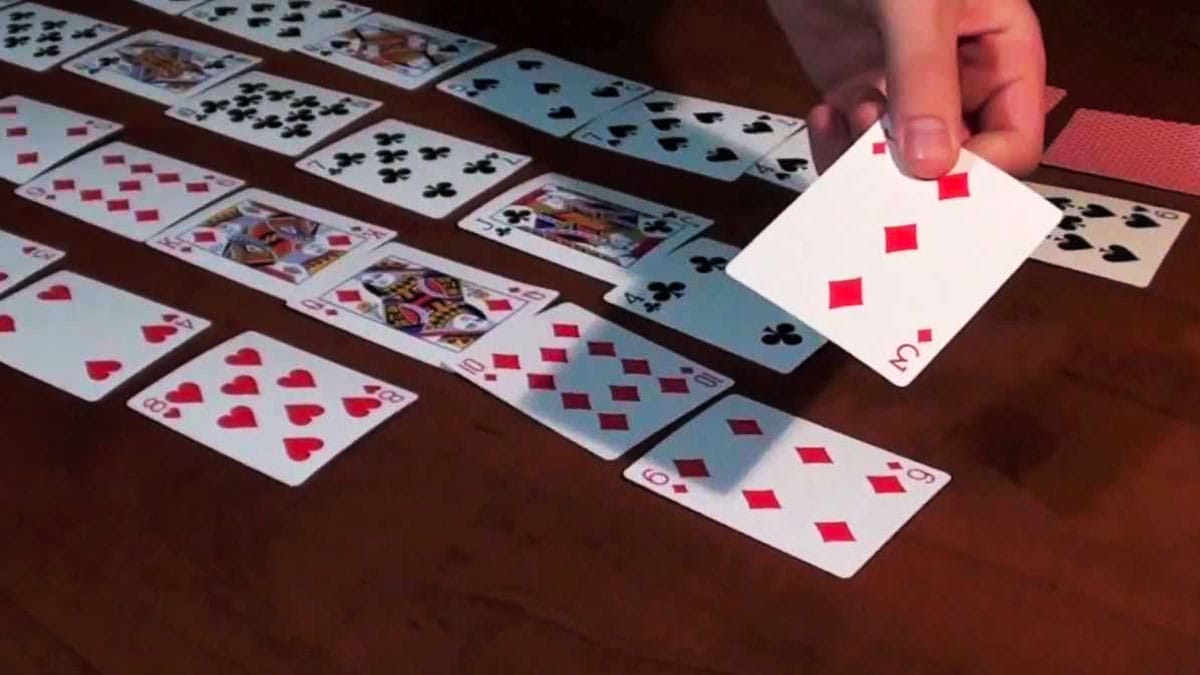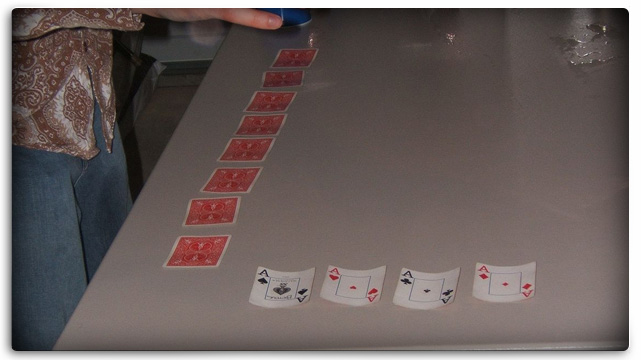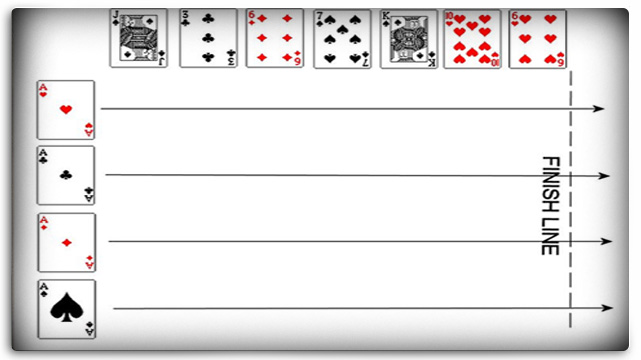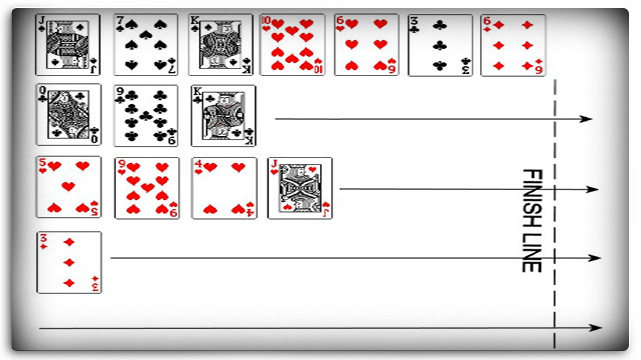How to Play Horse Race (The Card Game)

Horse race (or “horserace”) is a popular card game/drinking game. Gamblers love it. If you’ve never played it before, or if someone else has suggested that you play, and you don’t remember the rules — this post is for you. It explains how to play the card game horse race in detail.
It’s traditional for the players to bet drinks on each of the aces. But you could bet money on the appearance of the aces, too.
I explain further below.
How to Get Ready for a Game of Horse Race
You’ll need a standard deck of 52 playing cards. You can find these at any convenience store. Nicer decks are fun to play with, and I prefer plastic playing cards like Kem, but you can use a cheap deck that costs 50 cents or less if you like.
Another option is to ask the local casino to give you one of their used decks of cards. They usually have a hole drilled in the middle, or their corners cut off so that you can’t sneak them into the game at the casino.
But neither of those countermeasures prevents you from using them to play horse race.
You then decide which player is going to be the announcer. He’s really the only person in the game who actually does anything. He prepares by going through the deck and taking out the aces. Each ace represents a horse.
He lays the horses up at the end of the table to represent gates. The cards are laid face up and next to each other. If you imagine how the gates at a horse race look, then you’re on the right track.
Then the announcer shuffles the deck and deals an arbitrary number (often 6, 7, or 8) of face-down cards in a straight line at a right angle to the row of aces. You’ll find up with an L-shaped layout of playing cards, with the links (the face-down cards) forming one side of the L, and the aces (face-up) forming the other side of the L.

Now you’re ready to play.
How to Bet in Horse Race
Betting can be easy or complicated, depending on how seriously you’re taking the game.
You can just bet on which suit is going to win.
You might bet a flat amount on spades to win.
But if you’re interested in horse racing, you know that there are all kinds of other bets available, such as:
- Daily doubles
- Exactas
- Trifectas
Common Bets in Horse Racing
Here’s a list of the most common bets in horse racing and what they mean.
- Win is just a bet on which horse wins the race.
- Place is a bet that a specific horse will win first or second place.
- Show is a bet that a specific horse will win first, second, or third.
- Across the board consists of three bets, one each on win, place, and show.
- Exacta is a bet on which two horses will place first and second. These must win in that order.
- Trifecta is a bet on which three horses will place first, second, and third, in order.
- Superfecta is a bet on which four horses will place first, second, third, and fourth, in order.
Those are the most common bets, but there are plenty of others.
In a lot of games, though, players just choose their suit, and they have a payout set for first, second, and third place, as follows:
- First place gets 25
- Second place gets 20
- Third place gets 15
Sometimes, you’ll also see players make proposition bets, like who’s going to be the first horse out of the gate. You can even penalize a player if he bets on a horse that never gets out of the starting gate.
It’s customary to have betting limits, too. Otherwise, you’d wind up with goofballs betting 150 on spades or something like that.
When you’re playing horse race as a drinking game, it’s customary for the winner to distribute drinks equal to the amount he bet. It’s also customary for the winner to not have to drink. (For an old alcoholic like me, that’s not much of a win.)
How Horse Race Is Played
Gameplay in horse race is ridiculously simple.
The announcer starts the race by flipping over the top card of the cards left in the deck. He looks at the suit of that card, and that’s the ace that gets to move forward to that link. A good announcer will narrate the action with verve and vigor, and if you have a good crowd of players, you’ll have plenty of people cheering and booing the action.
The announcer keeps flipping cards in order, advancing the horses based on the suits of the cards being flipped over. The first horse to pass through the last link into the winner’s circle is the winning horse.
In some games, the optional rule for faltering is used. If a horse moves up to a new link for the first time, the announcer flips over the card that represents that link. The suit on that card must fall back one link.
Since there’s only a single card representing each link, this only can happen the first time a horse gets to that link.
This adds an additional layer of randomness to the game, which can be equal parts frustrating and exciting.
Also, if a horse is still in the gate, it can’t be knocked further back because of faltering.
You’ll even see some games with a rule for stumbling. In these games, the joker is left in the deck, so you’re playing with a 53-card deck instead of a 52-card deck. If the joker gets flipped over, all the horses (except for the lead horse) get to move up one link.
Betting for Real Money at the Card Game Horse
The announcer takes the bets and pays out the winners. He sets the odds, and the trick is to set the odds so that he has a reasonable chance to make a profit. The players also need to find the odds attractive enough to place bets on those propositions.
In games where you play for real money, the links are played face up so that you know the suits that are out there. The more cards of a suit that are already on the table, the less likely it will be for the horse of that suit to win the race.
Do you see why?
You have the aces for each suit at one end of the table already.

That leaves 12 cards of each suit.
Let’s say you have eight links, two of each suit. That leaves ten cards of each suit in the deck. Each ace has the same probability of winning.
But suppose you have four hearts in the links, two clubs, one spade, and one club.
Clubs and spades are tied as favorites to win the horse race because there are still nine of each card left in the deck.
The hearts are a big underdog because there are only six hearts left in the deck.
These are common odds based on how many cards of each suit have been laid out with seven links:
- If no cards of a suit are out there, then winning pays even money.
- If one card of a suit is out, winning pays off at 2 to 1.
- If two cards of a suit are out, winning pays off at 3 to 1.
- If three cards of a suit are out, winning pays off at 5 to 1.
- If four cards of a suit are out, winning pays off at 10 to 1.
- If five cards of a suit are already dealt, the cards are re-shuffled, and new links are dealt.
Calcutta Horse Race
On the excellent card game site Pagat, a variation called Calcutta is described. The rules are based on Calcutta auctions, like the ones held at the Melbourne Cup. You need at least three players for this variation, but six to eight players is better. Also, each player should start with the same amount of money.
In Calcutta, you cut cards to choose who’s going to be the announcer. The highest card gets to announce. The announcer can participate just like the other players.
He’s also responsible for being the auctioneer. The auction is what makes this variation of horse race so interesting.
After the aces are removed from the deck, the rest of the deck gets shuffled. The announcer deals out the seven cards that make up the links of the course. If five cards (or more) of a single suit are dealt, he has to re-shuffle and re-deal.
The announcer also sorts these cards by suit. This makes it easier to see which horse has an advantage, which is important for deciding how much you want to bid during the auction. It’s customary to put these in order from most cards to least to make it as easy as possible to differentiate the suits.

The aces are auctioned off beginning with the longshots, just like at the Melbourne Cup. The longshot is the suit which has the most cards dealt out in the links. Remember, that’s the suit that has the fewest cards left in the deck.
The bidding in the auction starts with a single unit — usually one chip if you’re playing with chips. (I suggest trying this with clay poker chips, by the way. They’re much more satisfying to play with than plastic chips.)
Players can bid at any time. If you’ve run an auction in a game like Monopoly, you already know how this goes. Each horse (ace) is sold to the highest bidder. That money goes into the pool. The player who wins that horse gets the ace to show that he owns that horse.
The game is played normally until a first- and second-place winner are determined. The owner of the first-place horse gets 2/3 of the pot. The owner of the second-place horse gets 1/3 of the pot.
If you can’t divide the pot by three, you round the winnings off to the nearest whole number. This will result in either one or two extra chips being left in the pot. If there’s only one chip left, it goes to the first-place winner. If there are two chips left, each player gets one of them.
Other Racing-Themed Card Games
This is the most common betting game version of the card game horse race that I know of, but it’s actually part of a larger category of card games called racing games.
In most card games with a racing theme, the cards themselves don’t actually race. Instead, a marble or a peg is moved around a board of some kind.
You could play Parcheesi with cards instead of dice.
Sorry! is a classic example of a racing game, too. It uses a proprietary deck of cards numbered from 1 through 12 (there are no 6s or 9s, though). The deck also has “sorry” cards which allow you to change places with one of the other players in the race.
Of course, if you’re using cards, you can deal players a hand of cards so that they have some choice in which card to play. This can convert a racing game that is just a game of chance into a game with an element of skill.
Other games in this category include Fast Track, Pegs and Jokers, and Tock.
Conclusion
And that’s how you play the popular card game horse race. There are enough variations that it can be played differently from one game to another. Next time you’re at a home poker game, you should give it a try.
I like the versions where you bet real money instead of playing it as a drinking game. For one thing, gambling should be about money, and drinking should be about alcohol. I don’t want to mix the two.
For another thing, gambling is all about fun.
Drinking is serious business.
Those are just my opinions, though — you play the way you want to.

 Author:
Author: 